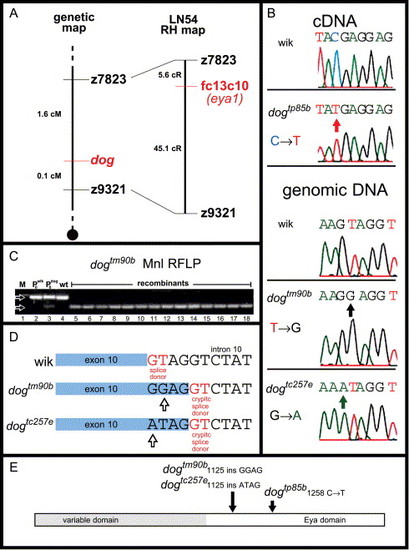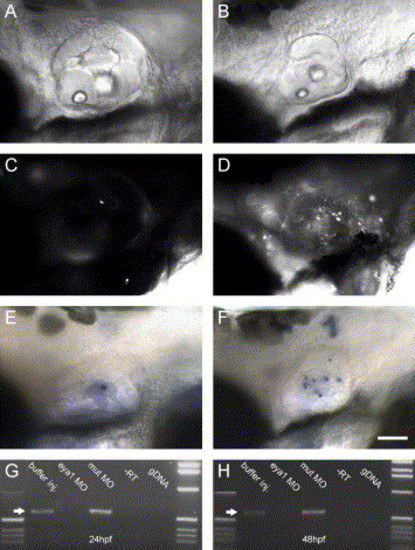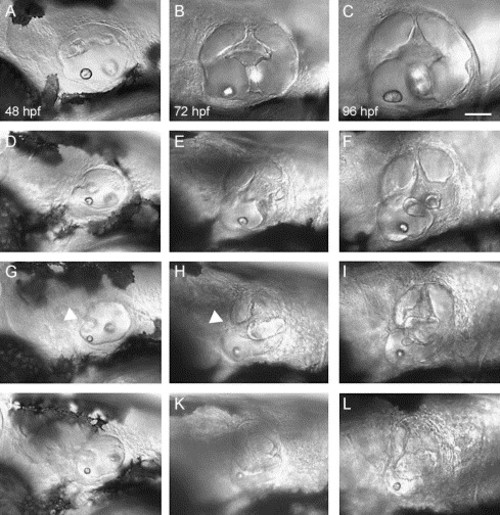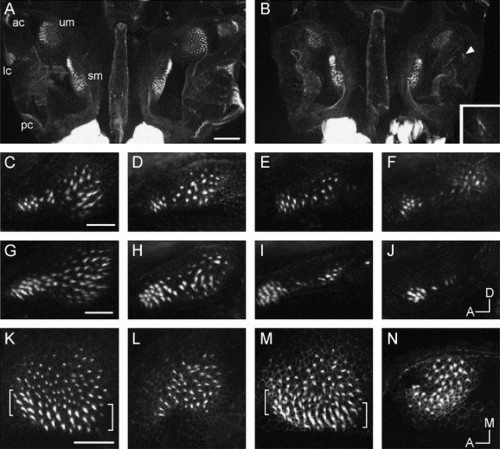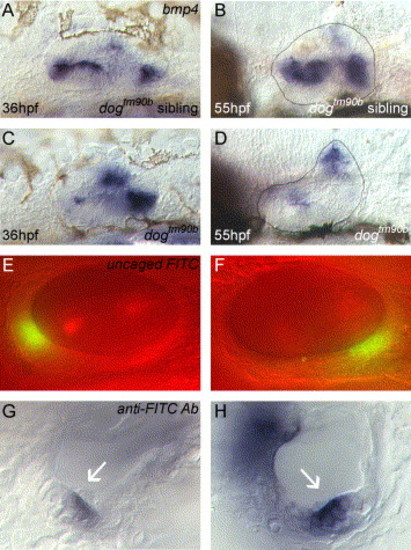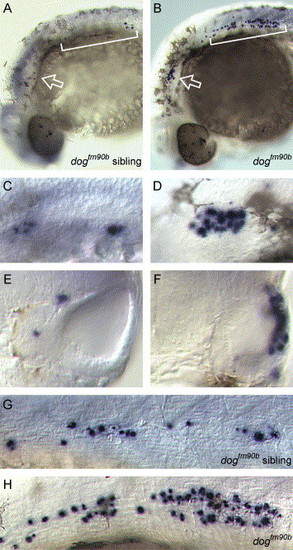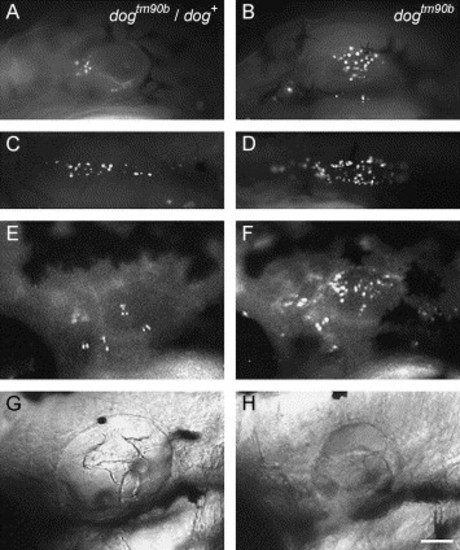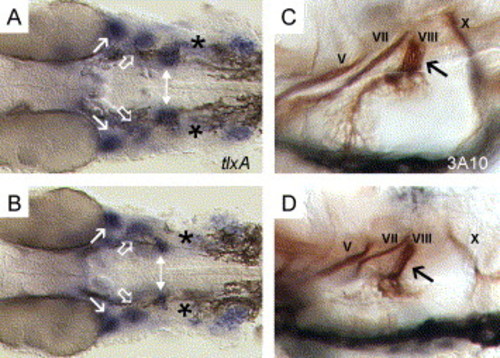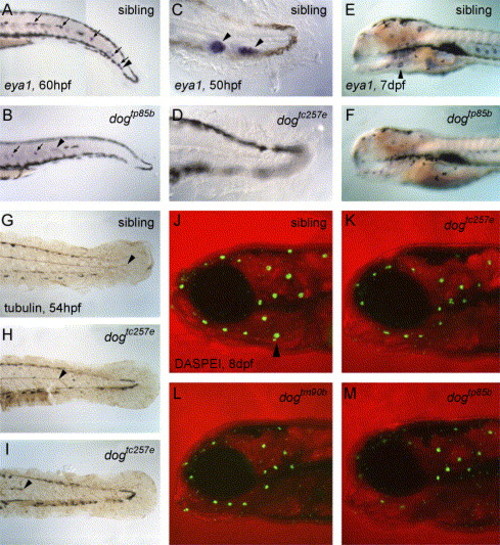- Title
-
The zebrafish dog-eared mutation disrupts eya1, a gene required for cell survival and differentiation in the inner ear and lateral line
- Authors
- Kozlowski, D.J., Whitfield, T.T., Hukriede, N.A., Lam, W.K., and Weinberg, E.S.
- Source
- Full text @ Dev. Biol.
|
The dog locus encodes eya1. (A) Physical and genetic maps of linkage group 24 (LG24) showing map positions of dogtm90b and eya1. (B) Sequence analysis of eya1 in wild-type (WIK), dogtp85b, dogtm90b, and dogtc257e mutants. Note that the T to G transversion in dogtm90b genomic DNA creates a novel MnlI recognition sequence (3′-G G A G (N)6-5′). (C) Linkage analysis via dogtm90b-specific MnlI RFLP on genomic DNA from wild-type (lanes 2 and 4), heterozygous (lane 3), and dogtm90b (lanes 5–18). The diagnostic dogtm90b eya1 allele is 82 bp (bottom arrow) and the wild-type eya1 allele is 118 bp (top arrow). (D) Box diagrams represent point mutations and splicing product in wild type (WIK), dogtm90b, and dogtc257e. Open arrows show the mutated nucleotides in the two alleles. (E) Box diagram representing conceptual translation of eya1 cDNA. Locations of each dog allele specific mutation are noted by black arrows. |
|
Morpholino-mediated phenocopy of dog-eared. Lateral views of control (A, C, and E) or eya1MO-injected (B, D, and F) embryos at 72 hpf. (A and B) Otocyst morphology as viewed by DIC microscopy. (C and D) Otocyst cell death visualized by acridine orange staining of live embryos shown in panels A and B. (E and F) Visualization, using the TUNEL assay, of apoptotic cell death in the otocyst of embryos shown in panels A and B. Anterior to left and dorsal to top. Scale bar, 100 μm. (G and H) RT-PCR analysis of eya1 mRNA processing at the exon10–exon11 junction in eya1MO-injected, or mismatched morpholino (mutMO)-injected, or buffer-injected embryos at 24 hpf (G) and 48 hpf (H). Products of reactions lacking reverse transcriptase (RT) or containing genomic DNA (gDNA) are also shown. The white arrow indicates the position of the expected 605-bp fragment amplified from correctly spliced mRNA. Each lane represents five pooled embryos. |
|
Range of severity in dogtm90b otocyst phenotypes. Lateral views of live embryos at 48 hpf (A, D, G, and J), 72 hpf (B, E, H, and K), and 96 hpf (C, F, I, and L). (A–C) Phenotypically wild-type embryo. (D–F) Weak otocyst phenotype. (G–I) Moderate otocyst phenotype. (J–L). Severe otocyst phenotype. Scale bar, 50 μm. |
|
Sensory patch phenotype in the ears of dog-eared homozygous embryos; confocal images of embryos and larvae stained with FITC-phalloidin. (A) Dorsal view (anterior to top) of a dissected preparation of the two ears of a 5 dpf wild-type sibling larva showing five distinct sensory patches in each ear: the utricular and saccular maculae (um, sm), and the anterior, lateral, and posterior cristae (ac, lc, pc). Scale bar, 50 μm. (B) The ears of a dogtm90b homozygote. Hair cells of the cristae are not visible in the left ear; in the right ear, three hair cells are present in the region where the lateral crista would normally form (magnified in inset). (C–J) Abnormalities in the saccular macula (orientation shown in J: anterior to left, dorsal to top): (C) lateral view of wild type, 3 dpf; (D–F) examples of saccular maculae from dogtm90b homozygous mutants, 3 dpf; (G) wild type, 5 dpf; (H–J) examples of saccular maculae from dogtm90b homozygous mutants, 5 dpf. Scale bar, 20 μm. (K–N) Abnormalities in the utricular macula (orientation shown in N: anterior to left, medial to top): (K and M) dorsal views of utricular maculae from phenotypically wild-type siblings, 5.5 dpf; (L) dogtm90b homozygote, 5.5 dpf; (N) dogtp85b homozygote, 5.5 dpf. Brackets to the left and right of the wild-type maculae shown in K and M indicate the hair cells with long stereociliary bundles located at the lateral edges of the maculae; this type of hair cell is mostly absent in the maculae of dog embryos (L and N). Scale bar, 20 μm. |
|
Otocyst expression of bmp4 mRNA in dogtm90b and fates of cells within ventrolateral domains. (A and B) Four domains of bmp4 mRNA expression are detected in wild-type siblings at 36 (A) and 55 hpf (B) (Mowbray et al., 2001). (C and D) In dogtm90b, bmp4 mRNA expression is variably reduced in two of the ventrolateral domains and in some embryos is increased in the posterior ventrolateral domain and in the dorsal domain at 36 hpf (C). At 55 hpf, bmp4 mRNA expression in dogtm90b is virtually absent in all three ventrolateral domains, but not in the dorsal domain (D). For each of the 55 hpf embryo panels (B and D), a line has been drawn at the margin of the otic vesicle to better indicate the position of bmp4-expressing cells. (E and F) Labeling of cells by uncaging of fluorescein within anterior (E) or posterior (F) ventrolateral domains of bmp4 expression. Focal planes shown are more medial than the uncaged cells to demonstrate more clearly the location of uncaged cells relative to anterior–posterior and dorsal–ventral axes of the otocyst. The uncaged cells are more lateral than the cells in the focal plane shown. (G) Anterior ventrolateral cells labeled in E are detected in the anterior crista (white arrow) and semicircular canal at 72 hpf. (H) Posterior ventrolateral cells labeled in F are detected in the posterior crista (white arrow) and semicircular canal at 72 hpf. Embryos in A–F are shown in lateral views with anterior to the left. Embryos in G and H are shown in dorsal views with anterior to the left and medial to the top. |
|
Increased apoptotic cell death in dogtm90b. Whole mount visualization of TUNEL-positive cells (blue) in wild type (A, C, E, and G) and dogtm90b mutant (B, D, F, and H) embryos. (A and B) Lateral views of wild-type sibling (A) and dogtm90b (B) embryos at 28 hpf. In mutant embryos, increased numbers of TUNEL-positive cells are seen in the region of the otocyst (arrow) and migrating primordium of the posterior lateral line (bracket). (C and D). Higher magnification view of otocysts in wild-type sibling (C) and dogtm90b (D) embryos. (E and F) Transverse sections through the otic vesicles of embryos shown in panels A and B. Note that TUNEL-positive cells are located within the lateral otocyst wall of dogtm90b embryo. (G and H) Higher magnification view of TUNEL-positive cells in the migrating primordium of the posterior lateral line in wild-type sibling (G) and dogtm90b (H) embryos shown in A and B, respectively. Panels E and F: dorsal to top and lateral to right. All other panels: lateral views with dorsal to top and anterior to left. |
|
Time course of cell death in dogtm90b. Single wild-type (A, C, E, and G) and dogtm90b mutant (B, D, F, and H) embryos stained with acridine orange at 48 hpf (A–D) and 72 hpf (E and F). (A and B) dogtm90b embryos show an increase in the number of acridine orange-positive cells in the otic vesicle (B) and migrating primordium of the posterior lateral line (D) relative to wild-type siblings (compare A, B and C, D). (E and F) The same wild-type sibling (E) and dogtm90b (F) embryos as shown in the previous panels continue to exhibit an increased number of AO-positive cells at 46 hpf. (G and H) Otocyst phenotype of dogtm90b (H) and wild-type sibling (G) embryos shown in (A, C, and E) and (B, D, and F), respectively. All panels: anterior to left, dorsal to top. Scale bar, 100μm. |
|
Statoacoustic ganglion phenotype in dogtm90b. (A and B) Expression of tlxA mRNA in wild-type sibling (A) and dogtm90b (B) embryos. Fewer tlxA-expressing cells are found in the SAg of dogtm90b (double-headed arrow, panel B) embryos when compared to wild-type siblings (A). Numbers of tlxA-expressing cells in the trigeminal (line arrow) and anterior lateral line ganglia (open arrow) are comparable in wild-type siblings and mutants. (C and D) Lateral views of axonal projections around the otocyst expressing the 3A10 epitope. In dogtm90b embryos (D), there are longer, but fewer, axonal projections in the VIIIth nerve (black arrow). (A and B) Ventral view, anterior to left. (C and D) Dorsal to top and anterior to left. Asterisks mark the otic vesicles. EXPRESSION / LABELING:
|
|
Lateral line phenotype in dog alleles. (A) Expression of eya1 mRNA in posterior lateral line neuromasts (arrows) of a phenotypically normal sibling embryo at 60 hpf. Migration of the posterior lateral line primordium (arrowhead) is complete. (B) In the tail of a dogtp85b mutant, eya1 is expressed in the nascent neuromasts (arrows), but the primordium has not reached the tail tip (arrowhead). (C and D) Higher magnification view of eya1 expression at the tip of the tail at 50 hpf. eya1 is strongly expressed in the primordium and neuromast (arrowheads) in the wild-type sibling embryo, but no eya1-expressing lateral line cells have reached the tail tip in the dogtc257e mutant. (E and F) By 7 dpf, eya1 is still strongly expressed in all neuromasts in the wild-type sibling. Expression is weaker in the dogtp85b mutant, and neuromasts of the opercular line (arrowhead) are missing. (The eyes have been removed for clarity.) (G, H, and I) Dissected preparations of tail skin from 54-hpf embryos stained as whole mounts with an antibody to acetylated tubulin showing the extent of the posterior lateral line nerve. In the dogtc257e mutant, the nerve terminates before the tail tip. (J–M) Confocal images of live embryos stained with the vital dye DASPEI showing hair cells in the neuromasts of the anterior lateral lines (green dots). In all three dog alleles, the neuromasts have fewer hair cells than normal, and neuromasts of the opercular line (arrowhead) are missing. Note also the rounded shape of the jaw in all three dog alleles. |

Unillustrated author statements |
Reprinted from Developmental Biology, 277(1), Kozlowski, D.J., Whitfield, T.T., Hukriede, N.A., Lam, W.K., and Weinberg, E.S., The zebrafish dog-eared mutation disrupts eya1, a gene required for cell survival and differentiation in the inner ear and lateral line, 27-41, Copyright (2005) with permission from Elsevier. Full text @ Dev. Biol.

